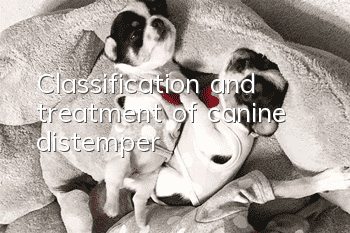Classification and treatment of canine distemper

1. About "Canine Distemper"
Canine distemper is a viral disease, and its pathogen is canine distemper virus (CDV) of the Paramyxoviridae family.
The virus is a single-stranded RNA virus with an outer layer covered by a lipoprotein envelope.
The natural hosts of canine distemper virus are canines and mustelids.
If dogs are infected with the virus, they often show respiratory or gastrointestinal symptoms, and may also have neurological symptoms.
The severity and mortality of canine distemper are related to whether there are secondary infections.
Most dogs will show neurological symptoms 3 to 4 weeks after infection, and severe cases may die.
Canine distemper is a disease that can infect dogs of different ages, genders, and breeds.
Puppies under 1 year old are most susceptible to infection, and purebred dogs are more susceptible than native breed dogs.
The incubation period of canine distemper is 3-6 days. Generally, there will be symptoms of rising body temperature about 4 days after infection, similar to a common cold. It will get better after 1-2 days, but then the body temperature will rise again. up to around 40°C.
In addition, canine distemper often manifests as depression, reduced food intake, and respiratory or digestive tract symptoms. Some dogs may also experience neurological symptoms.
The main source of infection of canine distemper is sick dogs. There are a large number of viruses in their nasal mucus, saliva, tears, blood, cerebrospinal fluid, lymph nodes, liver, spleen, pericardial fluid, pleural effusion and ascites, and they can be excreted through urine for a long time.
Canine distemper is mainly spread through two ways.
One is that sick dogs come into direct contact with healthy dogs; the other is infection through indirect routes, such as inhalation of droplets through the respiratory tract or infection through the digestive tract of contaminated food.
Canine distemper can occur throughout the year, but is more likely to occur during the cold season.
In clinical practice, canine distemper presents with different symptoms, but common symptoms include respiratory and digestive tract problems.
The main symptoms are respiratory symptoms, including purulent mucus in the eyes and nose, sneezing and coughing.
In severe cases, pneumonia will occur, and abdominal breathing is the main method at this time.
Digestive system symptoms caused by canine distemper include decreased digestion, vomiting, constipation and malignant diarrhea in the later stages, with mucus or blood appearing in the feces.
Nervous symptoms manifest differently due to damage to different parts of the central nervous system. Damage to the brain manifests as epilepsy, restlessness, spinning, and mental abnormalities; damage to the midbrain, cerebellum, vestibule, and medulla oblongata manifests as movement or standing. Postural abnormalities; spinal cord damage may manifest as ataxia and abnormal reflexes.
In addition, dogs with canine distemper will have repeated paroxysmal tremors and twitches in the masticatory muscles, which is also one of the common symptoms.
At present, there is no simple and practical method for diagnosing canine distemper. Routine diagnosis is often carried out by combining epidemiological investigation, clinical manifestation analysis and routine blood tests.
Canine distemper is a highly contagious epidemic. Crowded breeding farms and trading places with poor sanitary conditions can easily lead to the outbreak and epidemic of the disease.
Although strict epidemic control measures can cut off the transmission of the disease, the marketThe lack of regulation and the fact that vaccination is not compulsory provide a breeding ground for the spread of canine distemper.
Therefore, epidemiological analysis and immune status analysis show that the source of dogs should be considered an important factor in the disease.
For example, if there is an outbreak of canine distemper in a kennel or community, other dogs sold or living there may be infected.
In this case, the best way to prevent canine distemper is immunization. There must be four indispensable conditions: standardized immunization procedures, high-quality vaccines, strict health examinations and correct vaccination. Ensure successful immunization.
The classic clinical manifestations of this disease include bidirectional fever or persistent high fever, purulent conjunctivitis, keratosis of the foot pads, cracked rhinoscope, suppurative bronchopneumonia (respiratory type), and bloody stools that look like ketchup ( Gastrointestinal type) and possible neurological symptoms.
After canine distemper infection, the total number of white blood cells in most dogs drops significantly, only about one-third of the normal value.
At 5 to 8 days after infection, the dogs' white blood cell differential counts showed a decrease in the number of lymphocytes and an increase in the number of neutrophils.
The lowest number of lymphocytes accounts for only 3% to 5% of the total number of white blood cells, while the number of neutrophils can be as high as 93% to 97% of the total number of white blood cells.
IV. Treatment of canine distemper
Treatment plan (1) For cases in the early stage of the disease, treat both the symptoms and the root cause.
Because the canine distemper virus can cause lesions in the dog's thymus and other immune organs and destroy immune function, leading to a decrease in the immune response of dogs infected with canine distemper, measures to inject antibodies must be taken to control the development of the virus.
Canine distemper is usually treated with antibiotics, but these drugs can damage the dog's immune system, thereby creating conditions for infection by other pathogens.
These secondary infections can cause pneumonia, enteritis, liver, kidney, heart and other diseases, making the condition worse.
Eventually, the sick dog may be on the verge of death from the associated lesions.
Symptom control medications can be used to relieve symptoms in sick dogs with high fever, cough, vomiting, diarrhea, bleeding, loss of appetite and neurological problems.
About "Classification and Treatment of Canine Distemper"The editor has also compiled the following content for you, which may also be helpful to you:
Canine distemper is a disease caused by canine distemper virus Canine diseases can cause widespread concern in the canine medical community.
There are many classification methods for canine distemper. Common classification methods are as follows: 1. According to the time of occurrence: it can be divided into acute, subacute, chronic and other types.
2. According to clinical manifestations, it is divided into: digestive type, neurological type, respiratory type, urinary type, ophthalmic type, etc.
3. According to the classification of pathogens: it can be divided into canine distemper virus type 1, type 2 and virus subtypes.
Different types of canine distemper have different treatments.
Generally speaking, the treatment methods for canine distemper include drug treatment and supportive treatment: 1. Drug treatment: At present, the main treatment methods for canine distemper are the use of antiviral drugs, antibiotics, immunomodulatory drugs, etc.
2.Supportive treatment: including providing a highly nutritious diet, keeping warm, rehydrating fluids, supplementing oxygen, and symptomatic treatment.
In short, canine distemper should be diagnosed and treated as early as possible. At the same time, reasonable drug treatment and supportive treatment can significantly improve the dog's condition and increase the recovery rate.
1. There are four types of canine distemper symptoms: pneumonia type, enteritis type, cutaneous type, and neurological type.
The pneumonic type of canine distemper is mostly accompanied by enteritis-type symptoms such as diarrhea and bloody diarrhea. It is caused by the interaction between the lungs and the small intestine. This type of disease is often characterized by fever, lack of energy, and turbid secretions from the nose. , wet cough, occasional dry cough, shortness of breath, weakness, diarrhea, diarrhea and other symptoms; the skin type also belongs to this type, because the lungs open at the nose and are connected with the fur on the outside, which governs the surface of the body.
2. The heart and small intestine type are mostly critical syndromes with poor prognosis, often characterized by high fever, epilepsy, coma, red urine, confusion, etc. The heart governs the mind, and if the mind is disturbed, mental disorder will appear.
2. Diagnosis and treatment methods: In terms of treatment, medicines should be used according to the syndrome differentiation of the viscera. The principle is to treat the symptoms when it is urgent, treat the root cause when it is slow, and treat both the symptoms and the symptoms. The clearing method is mainly used.
The following groups of prescriptions have good therapeutic effects through the author's clinical practice: 1. Pneumonia type
- What should I do if my French bulldog vomits after eating dog food?
- How old does a husky need to be to become a dog?
- How to get rid of parasites in dogs and what should you pay attention to?
- What should I do to protect my dog’s food? Should he be beaten?
- What food is good for beagles to eat?
- Application of enema therapy in the diagnosis and treatment of clinical diseases in dogs and cats
- How to Feed an English Springer Spaniel for Beginners
- How to treat tear stains in dogs
- What should I do if my fawn dog loses hair seriously?
- Why do dogs need to be vaccinated?



